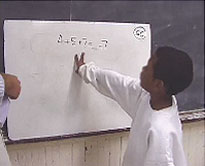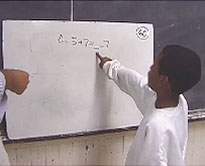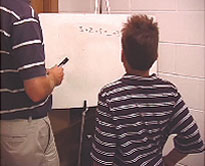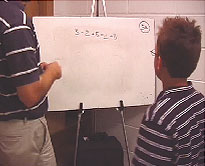Study shows how gesture aids in creating new concepts in learning
By William Harmsw-harms@uchicago.edu
News Office
|
|||||||||||||
Scholars long have known that movements help retrieve information about an event or physical activity associated with action. However, in a report published in the current issue of the journal Psychological Science, a study shows for the first time that gestures not only help recover old ideas, but also help create new ones.
The published study also suggests that gesturing helps students develop new ways of understanding mathematics.
“This study highlights the importance of motor learning, even in non-motor tasks, and suggests that we may be able to lay the foundation for new knowledge just by telling learners how to move their hands,” wrote lead author Susan Goldin-Meadow in the article “Gesturing Gives Children New Ideas About Math.”
Goldin, Meadow, the Beardsley Ruml Distinguished Service Professor in Psychology and the College, Susan Wagner Cook (A.B.,’00, Ph.D.,’04), now assistant professor of psychology at the University of Iowa, and University research assistant Zachary Mitchell collaborated on the article and the research.
For the study, 128 fourth-grade students were given problems of the type 3+2+8=__+8. None of thehe students had been successful in solving that type of problem in a pre-test. The students were randomly divided into three instruction groups.
One group was taught the words, “I want to make one side equal to the other side.” Another group was taught the same words along with gestures instantiating a grouping problem-solving strategy—a V-shaped hand indicating 3+2, followed by a point at the blank (group and add 3 and 2 and put the sum in the blank).
A third group was taught the words along with gestures instantiating the grouping strategy but focusing attention on the wrong numbers—a V-shaped hand indicating 2+8, followed by a point at blank. The experimenter demonstrating the gesture did not explain the movement or comment about it.
All of the students then were given the same mathematics lesson. On each problem during the lesson, they were told to repeat the words or words and gestures they had been taught.
After the lesson, students were given a test in which they solved new problems of this type and explained how they reached their answers. Students who repeated the correct gesture during the lesson solved more problems correctly than students who repeated a partially correct gesture, who, in turn, solved more problems correctly than students who repeated only the words.
The number of problems children solved correctly could be explained by whether they added the grouping strategy to their spoken repertoires after the lesson, Goldin-Meadow said. Because the experimenter never expressed the grouping strategy in speech during the lesson, and students picked it up on their own as a new idea, the study demonstrates that gesture can help create new concepts in learning.
“The grouping information students incorporated into their post-lesson speech must have come from their own gestures,” Goldin-Meadow said.
“Children were thus able to extract information from their own hand movements. This process may be the mechanism by which gesturing influences learning,” she said.
![[Chronicle]](/images/sidebar_header_oct06.gif)





